
🆕: Archaeologists have identified a key fortress of the Parthian Empire, which ruled from Turkey to Pakistan ~2,000 years ago, that may be a lost city.
An #AntiquityThread (paper: buff.ly/3INUXO5) 1/ 🧵
An #AntiquityThread (paper: buff.ly/3INUXO5) 1/ 🧵

The mountain fortress of Rabana-Merquly, in modern Iraqi Kurdistan, features four-kilometer-long defenses and two associated settlements. 2/10
📷: Location of Rabana-Merquly
📷: Location of Rabana-Merquly

Over the past 13 years, archaeologists from Germany and Iraq have been studying the site. They carried out excavations and fully mapped the site - something that could only be done with drones due to the mountainous terrain. 3/10
📷: Photo of the site taken from a drone
📷: Photo of the site taken from a drone

They identified structures that suggest military use, such as buildings that may have served as barracks, as well as a religious complex possibly dedicated to the Zoroastrian Iranian goddess Anahita. 4/10
📷: Citadel and (inset) barracks.
📷: Citadel and (inset) barracks.

Notably, they identified life-sized reliefs, including a depiction of a King of Adiabene (based on the dress of the figure, in particular, his hat). 5/10
📷: The king and his notable hat
📷: The king and his notable hat

Taken together, these indicate the fortress was built by the Adiabene, a vassal of the Parthian Empire that ruled on their eastern border. With its tough terrain, commanding view, and elaborate defenses it would have been a strategic site and taken a lot of effort to build. 6/10 

Additionally, the identification of the fortress as an Adiabene site means it could be the lost city of Natounia, which is known only from the coins it minted. It matches the city's description as a fortress near the Lower Zab river. 7/10
📷: Natounia coin
📷: Natounia coin

This could mean that one of the life-sized reliefs depicts Ntwn ͗šr/Natounissar (‘given by Ishtar’), an important Adiabene king thought to have founded Natounia. 8/10
📷: Location of the reliefs.
📷: Location of the reliefs.

This work provides important insights into the settlement structures and history of the Parthians, about whom there is surprisingly little knowledge even though they were a major power. 9/10
Read the full study FREE:
Rabana-Merquly: a fortress in the kingdom of Adiabene in the Zagros Mountains - Michael Brown, Kamal Rasheed Raheem & Hashim Hama Abdulla
doi.org/10.15184/aqy.2…
10/10
🧵
Rabana-Merquly: a fortress in the kingdom of Adiabene in the Zagros Mountains - Michael Brown, Kamal Rasheed Raheem & Hashim Hama Abdulla
doi.org/10.15184/aqy.2…
10/10
🧵

• • •
Missing some Tweet in this thread? You can try to
force a refresh





















